Note: This is the second of three related reviews. Start here.
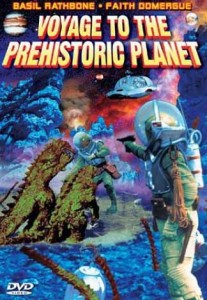
Warning! For this review to be (kinda) sensible, you’ll need to read this piece first.
Ah, one step closer to Jabootu sponsor Katherine Evan’s long ago requested film.
In the early ’60s, producer and legendary skinflint Roger Corman traveled to Eastern Europe and bought the rights to several Soviet sci-fi movies. He then stripped these films of their (for the time) expensive and elaborate special effect sequences. That accomplished, he had a collection of studio underlings frankenstein together several ‘original’ films by cutting in newly shot scenes featuring American actors.
The result was several drive-in standards, including Queen of Blood (1966) with Dennis Hopper. The earlier Battle Beyond the Sun (1962), meanwhile, featured new footage shot by a young Francis Ford Coppola. This might include a rather cheeky sequence in which a phallic monster ‘fights’ a rather emphatically non-phallic monster (if you know what I mean and I think you do), footage so jaw-droppingly hilarious that Joe Dante later appropriated it to great comedic effect for 1976’s Hollywood Boulevard. Man, if was Coppola who shot that, it would be the greatest thing ever.
Another such concoction was Voyage to the Prehistoric Planet, although that one went straight to TV. (Hence the lack of poster art for the film.) This proves a rather basic and generally faithful redub of the Soviet film Planeta Bur, with the obligatory new but ill-matching footage edited in. These latter sequences featured faded stars Basil Rathbone (!) and Faith Domergue, earning a day’s pay—probably literally—in exchange for whatever limited marquee value they would then command. Most of the rest of the credited American cast (the Russian actors who appear onscreen throughout are not credited at all) only provided dubbing.
The main change involves the character of female cosmonaut Masha. Due her isolation from the other characters for the bulk of the proceedings, Masha was easily excised. The entirety of her scenes were thus replaced with new footage featuring Domergue as the more Anglo-friendly ‘Marsha.’
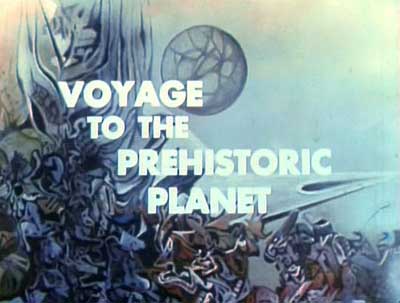
The opening credits play over a series of abstract alien landscape paintings by artist John Cline. Meanwhile, we hear a rather decent score by Corman’s regular composer, Ronald Stein. The result is actually fairly stylish. The film proper (so to speak) begins with some pretty impressive exterior space station shots from one of the other Soviet films Corman grabbed. This doesn’t have anything to do with anything, but helps pads out the film after they removed some unnecessary and/or inconvenient original footage.
Over these inserts is heard a typically stentorian Omniscient Narrator, who helpfully sets the scene:
“The year, 2020. The moon has been explored and colonized, and the next space goal is about to be reached. The first landing by man on the planet Venus. Scientists profoundly hope that life similar to that on Earth may be found on this planet, where so many physical conditions are like our own. [Uhhhhh….not so much.] Three rockets ships on an international expedition, the Sirius, Vega and Capella, after having successfully traveled 200 million miles, are in the final stages of their journey.”
This is rather strange, as the minimum distance Venus achieves from Earth is 25 million miles. You’d think they’d aim more towards that end of things, wouldn’t you?
Here we start in with the bulk of stuff from Planeta Bur, beginning with the meteor strike that destroys the Capella as it orbits Venus. After that brief bit, we cut to one of the film’s new sets. This represents the control room of expedition base “Lunar 7,” which unsurprisingly is supposed to be on the moon. This makes the previous space station shot even more pointless. And needless to say, the set isn’t exactly going to blow the mind of Ken Adam.
The space program is overseen by Prof. Hartman, played by Rathbone. Mr. Rathbone, it must be said, doesn’t appear entirely engaged in his performance. And who can blame him? Working for Corman, it’s entirely possible that Rathbone was engaged for a few days for another film entirely, and had a few hours left on the clock after wrapping his scenes for that.
That happened to Karloff during The Raven, whereupon Corman hurriedly shot some completely unrelated footage that the movie The Terror was later built around. If I had to guess, I’d note that Rathbone performed basically the same role he does here in the following year’s Queen of Blood, and would assume he shot the scenes for both films at the same time.*
[*It turned out that I was pretty close to the mark on this. According to Mark Thomas McGee’s Roger Corman The Best of the Cheap Acts (1988, McFarland & Company), “A special deal was cut with Basil Rathbone. For $3,000 the actor would work for a day and a half on Queen of Blood, and the remainder of the second day would be spent on Voyage to the Prehistoric Planet (1965), which AIP intended to make strictly for the television market...” Meanwhile, Fred Olen Rey in his tome The New Poverty Row claims that Harrington’s total budget for fashioning both this and Queen of Blood was a grotesquely paltry–even for Corman–$33,000!]Hartman learns that of the Capella’s destruction by a “meteorite” [sic!] and calls the crew of the Sirius. Here, we again become acquainted with the Planeta Bur cast, although naturally they’ve been provided with shiny new anglicized yet ‘international’ names.
The Sirius Crew:
- Expedition leader Vershinin is now Commander Brendan Lockhart.
- Second in Command Bobrov is now Hans Walter.
- The impetuous Alyosha is now Andre Ferneau.
The Vega Crew:
- Team leader Shcherba is now Sherman.
- Scientist Dr. Kern remains Kern, presumably because his name wasn’t Russian to start with.
- As indicated above, Masha is gone entirely, replaced by Faith Demergue’s Marsha.
Note that the Soviet original version included at least one member from a capitalist nation, even if he was a sardonic and occasionally misguided one. In contrast, Corman fails to return the favor by not allowing even one of the purportedly international array of characters to remain Russian.
The new voices are a mixed bag. Kern is afforded a quite serviceable substitute. However, several others don’t really match their characters properly, with the result being that the film often plays like the American dub version of the old Speed Racer cartoons. As voiced here, the characters are also a lot more argumentative, individualistic and brash. This isn’t surprising, as Soviet films tended to emphasize the supposed struggling-as-one spirit of the proletariat. Think Star Trek: The Next Generation vs. Battlestar Galactica.
In any case, the remaining astronauts mourn the loss of their fellows aboard the Capella, just as they originally did. Once more, however, the culprit is misidentified as a “meteorite.” When even I catch a science mistake, you know it’s a doozy. They receive the same instructions from Hartman as they did the anonymous Control Voice in the Russian version, and react the same way. “Swell!” Andre grouses. “Orbit and wait!”
We learn that Hartman supposedly was the one who “built” their vessel. This is pretty typical for films from that period. Cinematic space programs were often run by some learned fellow who seemed to do pretty much everything, including designing and overseeing the construction of the rocket ships. Professor Quatermass would be an obvious example.
Andre wants to land on Venus immediately, and volunteers to do so himself. Along the way, robot Iron John is referred to as a “cybernetic machine.” Technically, that’s correct, but ‘robot’ seems like less of a mouthful. Andre also calls sneeringly calls John a “monster,” which seems a bit harsh.
Kern again calls John to ‘life’ (and again John is given a variety of names, including Monitor John and Automaton John) and again requests a plan for landing on Venus. “Be extra precise!” Kern warns. Good idea. John here is saddles with a quite irritating ‘robot’ voice, which apparently isn’t artificially processed but just a guy doing that ‘talk like a robot’ thing. (!!) Perhaps to cover this, the voice is accompanied by some extraordinarily irksome electronic sound effects. Why anyone thought this a good idea remains a mystery.
It’s at this point that we cut to Marsha for the first time. Like Masha, she is a member of the Vega crew. Even so, you don’t exactly have to be Sherlock Holmes—just ask Rathbone—to perceive that neither her uniform, equipment nor the lighting of the set they constructed for her remotely matches that of anyone or anywhere else on her ship.

Following the original plot, the astronauts receive permission from Hartman to let Sherman, Kern and Iron John fly down to Venus on the Vega‘s glider. Preparations proceed as before, and again Andre notices a red glow through the planet’s permanent cloud cover. Where he romantically envisions a brightly lit cityscape, however, the more pragmatic Kern assumes volcanic activity. “A planet of fire below us,” he muses. “Is it a new world, or will it consume us all?” Uhm…quite. (This line, remember, in the version scripted by an American.)
The glider heads down, but misgivings are quickly advanced. “White clouds!” Sherman radios the Sirius. “I don’t like the look of this.” Yes, too bad there was no way to predict such a thing from your sustained observation of a planet hidden under a thick canopy of, well, white clouds. However, he calms down after turning control of the craft over to John. “This is truly a prehistoric planet,” Sherman reports as they fly through thick fog. Uhm, OK.
They tell Sirius that there’s a landing spot at “square 73.” (Wow, this technical jargon.) Then the sound of an unexpected water landing is heard, followed by radio silence. Marsha over on the Vega naturally reacts the most violently to this. Lockhart, however, assures her the lost signal is most likely because their ships have now passed over the horizon from the glider party. She is ordered to rest until they come around again.
The silence continues past that point, however, so Lockhart orders the Sirius crew to prepare to land on the planet. He radios Marsha to apprise her of the situation, and advises her to remain calm. Hartman also chimes in via radio, just to sprinkle another brief and generally pointless Rathbone scene into the mix. His name, after all, appears first in the credits.
The Sirius lands safely, and the crew reacts laughingly to the reappearance of gravity. (This is a nice little moment I missed while watching the original version.) They turn on the “outside sound pick-up” and hear the eerie wailing, which is more traditionally science-fictiony here. As with John’s new ‘robot’ voice, this isn’t really an improvement. “What is it, a human being?” Andre asks. An odd question, as it sounds absolutely nothing like anything a human would make.
They prepare to head outside, and Lockhart orders the others to don their spacesuits. That’s why he’s in charge, I guess. Walter reads a gauge and reports that the atmosphere is “4.7 on oxygen,” which reassures Lockhart. “That’s pretty close,” he shrugs. They go outside, and things follow as they did before. To wit, Andre quickly wanders off and has an encounter with your standard Giant Carnivorous Plant. The others rush to his rescue, etc.
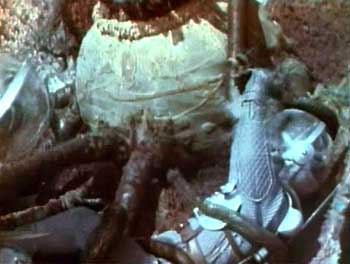
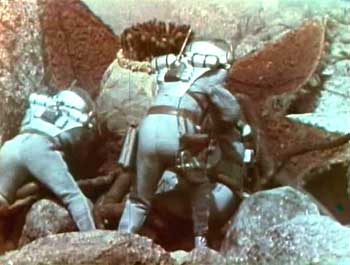
Following that escapade, which they quickly laugh off, they receive a message from Marsha. She’s picked up via scanner some moving objects that match the glider party. Per this, the Sirius crew sets out in their Bubble Car. However, first they radio Marsha for an exact fix on the glider party, which she failed to provide. “I was so happy you made a safe landing,” she gushes, “I forgot to tell you!” Also, one would guess, she was fussing with her hair and doing her nails. (Speaking of her hair, Domergue sports the mother of all beehives here. I mean, yikes.)
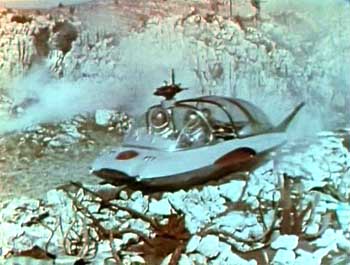
In one of this version’s myriad non sequiturs, Walter suddenly assumes something is wrong with the Robot. A call to Marsha confirms that “apparently they’re having some difficulty with it.” She can tell that from an orbital scan? Huh? She notes also that John is not yet fully assembled, which again I’m not sure how she would know. Sure enough, though, we cut to Kern and Sherman and they are now attaching John’s head and his second arm.
During this we get the attack by the Rubber Reptile Men, and so forth. Here I noticed a continuity error which I assume originates here due to pointless editing. If you watch the action, despite the fact that there are two guys in the glider crew, one fellow trips and two others are seen standing and shooting at the Reptiloid who then attacks him. In other words, Sherman trips (despite the helmets, we can tell because he and Kern are using markedly different pistols) and then also shoots at the reptile attacking himself some distance away.
Anyway, John is activated during the tussle and allows them to make their escape. I have to say, the attempts to give the dialogue an American feel are pretty lame. For instance, when Sherman carps about the mess they’re in, Kern ‘quips’ “Why don’t you catch a bus and go home?” Because, you see, they are on Venus, where there are no buses. Get it? Ho, there’s a knee-slapper. One can understand that they’d want to lighten up the comparatively dour original. They just could have done a better job of it.
Meanwhile, the Sirius guys see the dinosaur, etc. With the action now focused on the planet, the inserts with Marsha and Hartman grow predictably sparse. Therefore the film basically progresses just as it did the first time. The glider guys are sick and seek shelter in a cave before passing out. The Bubble Car Crew travels over the gulf and are attacked by a pterodactyl (who they attempt to repel with their “astro-gun” [!!]) and seek safety underwater, etc. All Marsha knows is that the Bubble Car has disappeared off her scanners, and begins to freak out. You know, like a girl would.
Here the whole sub-plot of her deciding to land the Vega is help off until the very end, however, introduced and then dealt with in a comparatively perfunctory manner. While this means the whole ‘girls are silly’ thing thus gets less time, the end result is even more sexist than the original. In Planeta Bur Masha comes to her senses on her own. Here Marsha would have proceeded to the surface, save that Hartman reestablished contact at the last moment and ordered her to stay in orbit. “I’m very grateful to him now,” she sighs. Super. Maybe you can bake him a mooncake when you get back to Lunar 7.
Otherwise, and as you might imagine, what interested me most this time around was noting the revisions made from the original. The discussions about the possibility of finding human-like life here remain but are unsurprisingly much shortened, while Darwin and Konstantin Tsiolkovsky go unmentioned. And in a rare improvement over the source material, the first movie’s oddly specific diagnosis of malaria is here judged to be a more generic, and hence believable, “infection.”
As I anticipated, a replication of the scene where Masha larks about weightless is forgone. I’d guess that was because of the time and money it would have cost to shoot, rather than because it was judged overly whimsical. And due presumably to American’s much greater comfort with technology, John’s derangement no longer occurs. He still tries to dump the guys during the lava scene, but that’s a solitary glitch due to poor programming rather than an ongoing problem. Moreover, his demise is more explicitly mourned in this version, rather than being used as an occasion to dwell on man’s superiority to machine.
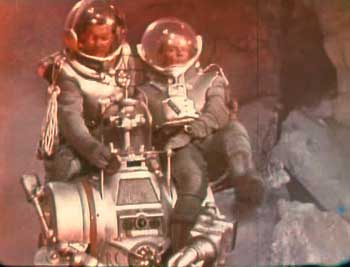
One other thing interested me. We see Marsha at one point reclining on her bunk bed, and unless I’m mistaken it’s the same one used in 1972’s Doomsday Machine. (That film, of course, also recycled footage from a notoriously large number of Soviet sci-fi pictures.) Such economical use of old set-dressing would hardly be surprising.
In any case, the revised film ends up being more or less a straight redo of the first. Not so much, so I hear, for the version yet to come….
AFTERWORD:
Roger Corman is at this point in time the biggest name associated with Voyage to the Prehistoric Planet. However, that would not have been true back in the day. The culture hadn’t gotten to a place where a producer or (non-studio) director had nearly as much fame as they might now. Prior to the Internet, I’m not even sure that would have been possible.
Even so, Corman’s role in this skein was rather indirect. He purchased the rights to several Soviet sci-fi extravaganzas, then ordered a number of talented youngsters in his stable—Curtis Harrington, Francis Ford Coppola, Peter Bogdanovich—to craft at least minimally releasable American product from them.
Curtis Harrington handled those chores here, ‘writing’ and ‘directing’ the revamped dialogue and shooting the new footage. He also performed similar duty for Queen of Blood. Like many Corman regulars, he tended to do any job required of him, trusting that he’d be allowed to work his way up the ladder. As such, he scripted, directed, played bit parts, produced and even eventually assistant produced (generally uncredited) on actual big studio films like Peyton Place and The Long Hot Summer, starring Paul Newman.
Mostly, though, he directed. He’s probably best known for his atmospheric Night Tide with Dennis Hopper (who was also in Queen of Blood), a film that has a sort of minor league Carnival of Souls reputation. Harrington went on to direct the occasional theatrical picture, like the supernatural revenge flick Ruby. Mostly, though, he toiled on various, often horror-themed TV movies (The Cat Creature, Killer Bees, Devil Dog: Hound from Hell, etc.) and episodes of series like Baretta, Logan’s Run, Wonder Woman and Vega$.
Again, though, Harrington’s name is undoubtedly better known today, if only among hardcore film nerds, than it was at the time he was working. Instead, the biggest names associated with the film back in the day were actors Basil Rathbone and, to a far lesser extent, Faith Domergue.
Rathbone presumably doesn’t need much of an introduction. He specialized in villains in such top-grade adventure films as The Adventures of Robin Hood, Captain Blood and The Mark of Zorro, pictures which utilized his superb fencing skills. Rathbone generally exuded a snobbish, supercilious air, in a manner reminiscent of Henry Daniell. This was true even when Rathbone played heroes, as he did opposite Bela Lugosi and Boris Karloff in The Son of Frankenstein.
Rathbone’s true immortality, of course, was achieved after he first assayed the role of the Sherlock Holmes in 1939’s The Hound of the Baskervilles. Rathbone’s natural haughtiness was a perfect match for Holmes, and his remained the definitive interpretation until Jeremy Brett arrived on the scene in the ’90s. Predictably, though, the quality of the Holmes films diminished as things went along. Much like Holmes creator, Sir Arthur Conan Doyle, Rathbone grew tetchy about his increasingly inescapable connection with the character.
As with most actors, Rathbone’s career waned in his later years. It must be said that he seemed to bear this situation with less grace than many. Admittedly, it must have been difficult to go from headlining ‘A’ pictures in Hollywood’s glory days to working in cheapie crap like this and Hillbillys in the Haunted House. Even so, Rathbone gave into the temptation to phone in his performances in such pictures, which was never the case with peers such as Boris Karloff. Rathbone did rouse himself for films he had a good part in, however, such as the Corman-directed Comedy of Terrors.
Faith Domergue, for her part, achieved her own lasting fame the way that many of her surprised fellows did, by appearing in what at the time must have seemed eminently disposable ’50s genre films. Whereas many stars of much bigger contemporary films of that time are all but forgotten, actors like Domergue will always have a small but rabid following for starring in pictures like Cult of the Cobra, This Island Earth and It Came From Beneath the Sea.
Those titles marked the height of her career, however. Predictably, she was soon regulated, like so many others, to episodic TV appearances and low-budget independent film work. Although only 41 at the time of Voyage to the Prehistoric Planet, she yet looks a bit worn around the edges. Certainly she appears quite a bit older than she had just a decade previously, when she was making her more famous sci-fi pictures. Also like many American actors, she eventually traveled to Europe to make films there. Following some rather desultory years, Ms. Domergue retired from the screen after 1974’s The House of Seven Corpses. She passed away in 1999.
The film’s music, including the decent opening score, were provided by composer Ronald Stein. Mr. Stein began composing for film back in the mid-’50s, and most of his work was featured in dozens of low-budget sci-fi films. Most of these, although not all, were for Corman. Titles include The Phantom from 10,000 Leagues, Day the World Ended, It Conquered the World and Dinosaurus!, to name but a few.
In particular, fans of Larry Buchanan’s films will recognize a good deal of music here. (I couldn’t say if this originated here or was itself recycled from an earlier film.) Certain themes are extremely familiar from being serially featured in such Buchanan’s z-grade genre flicks as Zontar Thing from Venus, Creature of Destruction and Curse of the Swamp Creature.
The Alpha budget disc I reviewed this from was obviously taken from a somewhat beaten-up and faded print. Even so, it’s a whole heck of a lot better looking than the gray market DVD I had purchased of the original Russian version of the film. Especially beneficial is that it’s much easier to make out facial expressions inside the space helmets, which adds a lot of nuance back to the acting.
As it turned out, it’s better than the transfer found on the same company’s Voyage to the Planet of Prehistoric Women. However, those seeking a decent presentation of the source film will find listings for a subtitled Region 0 DVD on eBay. In any case, I continue to hope that someday all three of these connected films will get a proper Region 1 release with good transfers, hopefully in a set.
Go the the review for Voyage to the Planet of Prehistoric Women.
